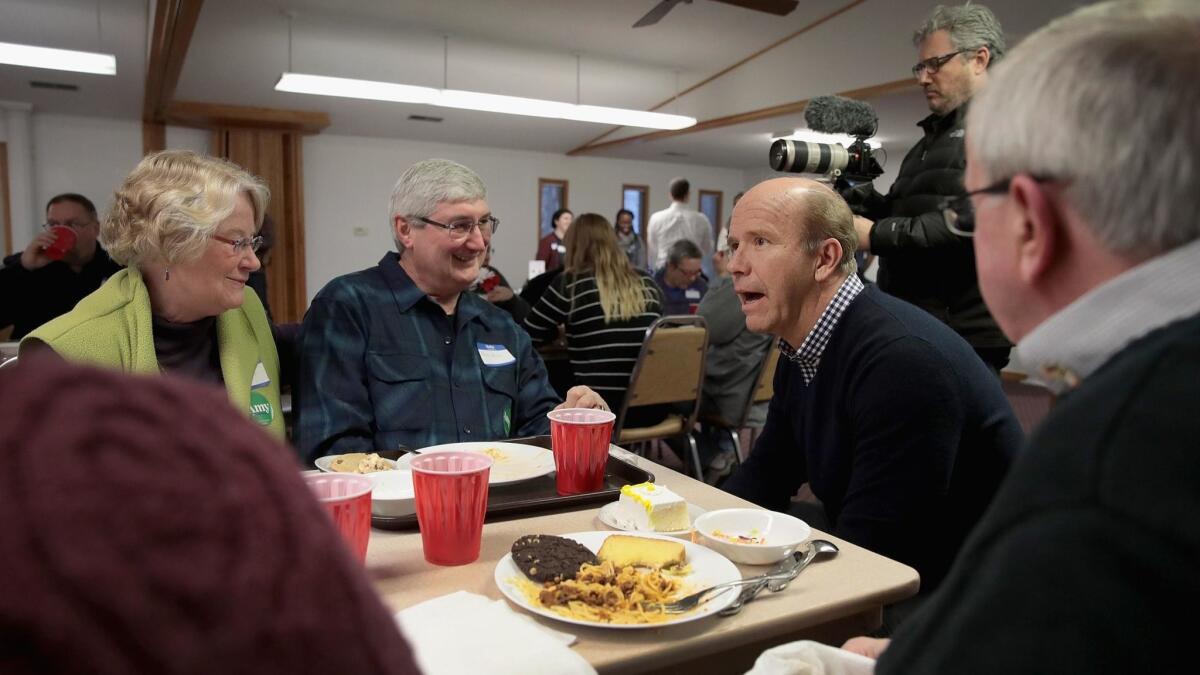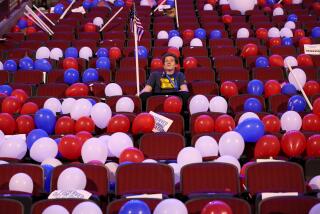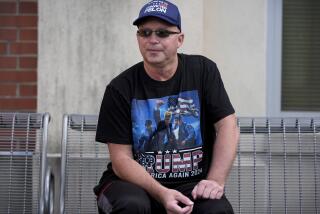Campaigns without end: Today’s presidential marathons took root in 1968

- Share via
Reporting from MARSHALLTOWN, Iowa — He’s back. And he’s been back. And back and back and back.
Since June 28, 2017 — 1,224 days before election day — former Rep. John Delaney has been campaigning for president. He’s been in Iowa, the site of the first contest of the 2020 election, 24 times. He’s done 250 campaign events and already visited all of Iowa’s 99 counties. All that with the election still 20 months away.
The Maryland Democrat — who hardly registers in polls in Iowa or New Hampshire, where he has made 14 campaign trips — gives new meaning to the notion of the loneliness of the long-distance runner. But he also is a symbol of a presidential-campaign system that has spiraled out of control, a nearly permanent campaign that stretches ever longer in its effort to appeal to an electorate that seems ever more cynical of politics and ever more impatient with the totems of modern campaigning.
“We don’t have nomination decisions made in the smoke-filled room anymore,” said Geoffrey Cowan, USC professor and the author of a book on Theodore Roosevelt’s 1912 White House campaign, widely regarded as responsible for the beginning of presidential primaries. “In that world you didn’t have to raise money and the bosses made the decisions. But now people have to build their constituencies among donors and volunteers.”
Barbara Trish, a political scientist at Grinnell College in central Iowa, summed up campaigning here this way: “These are no longer job interviews. They’re long courtships where people get to know the candidates as if they were dating.”
With six offices in Iowa and 20 paid staffers, Delaney has a rationale for what might seem like an irrational undertaking. He’s so much an underdog that his only chance is a daily grind of events in remote crossroads; in the last five weeks he campaigned in two towns with fewer than 3,800 people. And while Al Smith and Hubert H. Humphrey practiced the politics of joy, Delaney’s quest might be described as the politics of perseverance.
“I have the right vision and the right ideas, but not enough people know me,” he said before a forum in the Iowa Veterans Home here, “so I’m taking advantage of the long campaign and using every day to build support.’’
If the reaction to the long campaign in the United States is impatience, the perception beyond our borders is incredulity.
“We’re a G-7 country, and we manage to get an election started and finished in six weeks,” said Andrew Potter, a professor at Montreal’s McGill Institute for the Study of Canada.
“You have to find a better way to choose your leaders,” said Lawrence Goldman, a leading British scholar who taught American history at Oxford University. “It’s a much smaller operation here and the money is so much smaller, but we do this so much more efficiently.”
The Democratic National Convention isn’t until July 13, 2020, but as many as two dozen potential contenders are looking for an advantage in Iowa, hoping to win the most committed and connected aides and activists, and calculating that animus for Donald J. Trump makes their early entreaties welcome.
“I’m here early because I feel so passionately the president is taking us in the wrong direction,” New York Sen. Kirsten Gillibrand said after addressing several hundred anti-Trump Iowans in a Iowa City restaurant. “I want to start to meet people as early as possible.”
One of the people she met was University of Iowa freshman Teagan Roeder, who has heard stump speeches from a handful of presidential candidates. “This is a very competitive election,” he said, “and it’s important to get out there as soon as possible and to make the case for as long as possible.”
Though Andrew Jackson’s 1828 campaign arguably began the very day the legendary “corrupt bargain” catapulted his rival, John Quincy Adams, into the White House in 1825, prolonged presidential campaigns are a recent phenomenon.
In the 1960 election — the one political scientists generally mark as the beginning of modern politics — Sen. John F. Kennedy of Massachusetts, the eventual winner, began his campaign on the second day of the election year itself, only three days after his principal rival, Sen. Humphrey of Minnesota, announced on Dec. 30, 1959. As recently as 1968, candidate campaign announcements for Republican contenders came an average of 136 days before the nominating convention.
“There are no rules, so you can start campaigning for president years before an election if you want to,” said former Massachusetts Gov. Michael S. Dukakis, the Democrats’ 1988 nominee. “Sure, elections are too long, but this time we need a long campaign. It’s an incredible opportunity for Democrats to run a 50-state campaign to defeat this guy in the White House, and you’ll need a long campaign to reach all 50 states with the message.”
The long campaign has its origins in the overhaul of campaign rules that followed the 1968 election. Under the leadership of Sen. George S. McGovern of South Dakota and Rep. Donald M. Fraser of Minnesota, the Democrats — dispirited by their loss to Richard Nixon and fearful the party was being torn apart by rebellious factions who felt betrayed by Humphrey’s nomination at a raucous convention in Chicago — gave fresh emphasis to presidential primaries and high-participation caucuses.
McGovern won his party’s nomination in 1972 but lost to Nixon in a 49-state landslide. It wasn’t until the next election, in 1976, that the full implications of the new party rules — eventually generally adopted by the Republicans as well — had consequences.
Former Georgia Gov. Jimmy Carter saw the opening created by the rules and trudged for months through Iowa, winning precinct caucuses that were so unimportant four years earlier that not a word about the contest appears in any of the classic chronicles of that campaign, Theodore H. White’s “Making of the President 1972,” Tim Crouse’s “The Boys on the Bus” and Hunter S. Thompson’s “Fear and Loathing on the Campaign Trail ’72.”
“The Carter campaign changed everything,” said Peter D. Hart, a veteran Democratic pollster. “It set a new pattern for how you run for president. He took advantage of being out of office, and he went right to work and spent the next two years campaigning.”
The early birds, to be sure, do not always get the nomination worm. But late-entrant candidates — Gov. Jerry Brown of California in 1976 and Sen. Edward M. Kennedy of Massachusetts in 1980, for example — have said that their delays limited their fundraising and hindered their ability to recruit top-notch activists and volunteers.
“You have to build lists that will generate you money, and that is time consuming,” said Tad Devine, a strategist for the 2016 campaign of Sen. Bernie Sanders of Vermont. “And because our process to nominate someone takes place in all 50 states, each requires staff and organization. It is a very time-consuming process, and getting to the early states of Iowa, New Hampshire, Nevada and South Carolina — in four different parts of the country — early pays off. If you wait to the end of the year, you are at a distinct disadvantage.’’
Part of the disadvantage comes from the nature of the electorate in those early states.
Voters demand that candidates visit early and often, linger in their coffee shops, attend to their dozens of campaign rituals, such as the Politics & Eggs forums put on by the New England Council and the New Hampshire Institute of Politics at St. Anselm College. Over the Presidents Day weekend, seven presidential candidates visited New Hampshire — though the nation’s first primary was 51 weeks away.
“We expect these candidates to come here a lot, and we expect to meet them more than once,’’ said Dudley Webster Dudley, a onetime New Hampshire Democratic state legislator. “It’s not just a cliche. We meet them, we question them, we evaluate them. It’s part of the character of New Hampshire.”
It is no different in Iowa, where four years ago former Democratic Gov. Martin O’Malley of Maryland roamed the state looking for support, one afternoon dropping into a home in the soybean-and-corn town of Ogden (population 2,044) for fudge brownies and cinnamon coffee cake. As he spoke, one woman stood against the kitchen cabinets knitting a multicolored dishcloth. Then the candidate played the banjo for a spell.
“It’s important for the campaign to be long so we can get to know the candidates,” said Tracey Schmidt, who works in the IT department of the University of Iowa. “One week you think you’ll go in one direction and then you’ll meet another candidate and you think you’ll go in another direction. You really need time to home in on what is important to you and which candidate meets that.”
But the result, even in politics-mad states such as Iowa, often is campaign fatigue.
“I get sick of seeing the same ads over and over again,” said Lyle Muller, a former editor of the Cedar Rapids Gazette. “It’s the theater of the absurd. But if we used those two-year campaigns to examine issues and what candidates would do about them, we’d have a more thoughtful campaign, and the length would be worth it. But we don’t — and I’m dreading all the candidates coming in here and blitzing us.”
He’s not alone. “It would be better to have a shorter campaign,” said John Grennan, co-chairman of the Poweshiek County Democratic Party. “These long campaigns get in the way of governing, and everything is framed toward the election, toward getting votes, and not to making policy.”
That is not an idle theory. In his groundbreaking 1991 book “Divided We Govern,” Yale political scientist David R. Mayhew found that the number of major laws enacted in Congress was substantially lower in the last two years of a presidential term than in the first two years.
“By the late 1990s we have become so accustomed to marathon racers for the presidential nomination that we often lose sight of the many disadvantages they present for our system of government,” the political scientists Michael G. Hagen of Temple University and William G. Meyer of Northeastern University argued. “The difficulties are real and serious.”
How, they asked, can a candidate “attend to his governmental responsibilities while spending three or four days a week raising money, meeting with party activists, and campaigning in Iowa and New Hampshire?”
As a result, congressional lawmakers spend less time voting on legislation when seeking the White House.
Hagen and Meyer found that from 1952 to 1968, lawmakers running for president participated in 82% of the congressional votes in the calendar year before an election. From 1972 to 1996, such voter participation rates slipped to 65%.
Delaney, a former successful business executive before being elected to Congress in 2012 and serving three terms, ran a campaign ad during the 2018 Super Bowl, more than two years before the Iowa caucuses.
“His whole campaign is based on the idea of a long campaign,’’ said Rep. Mark Smith, whom Delaney started courting two years ago. Smith has yet to give him his endorsement but did attend a Delaney event in February, the same month Delaney won the nod of four county central committee chairs in Iowa, a small but heartening breakthrough.
Still, an early start doesn’t guarantee success. Sen. Christopher J. Dodd of Connecticut actually moved his family into a three-bedroom, three-bath home in West Des Moines a year before the 2008 election but withdrew after he finished sixth in the Democratic caucuses. O’Malley, with his banjo a constant presence in Iowa, didn’t win a single delegate in the 2016 caucuses and left the race immediately afterward.
And even early success doesn’t guarantee late success. Iowa caucus winners include Democrat Richard A. Gephardt of Missouri in 1988 and, among Republicans, Mike Huckabee of Arkansas (2008), Rick Santorum of Pennsylvania (2012) and Sen. Ted Cruz of Texas (2016).
All of them campaigned and flared early. None of them came close to winning the nomination.
Shribman is a special correspondent.
More to Read
Get the L.A. Times Politics newsletter
Deeply reported insights into legislation, politics and policy from Sacramento, Washington and beyond. In your inbox twice per week.
You may occasionally receive promotional content from the Los Angeles Times.










